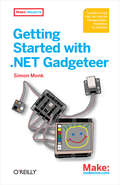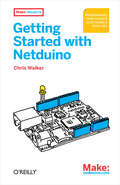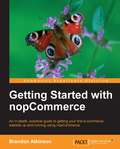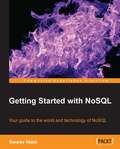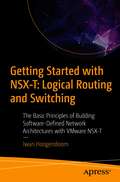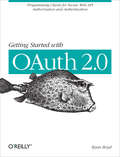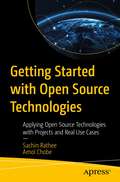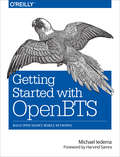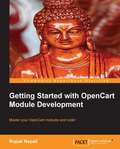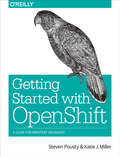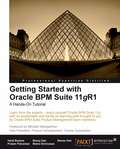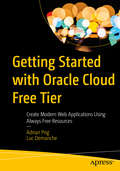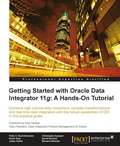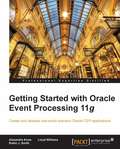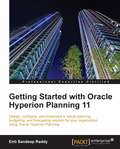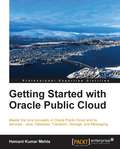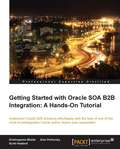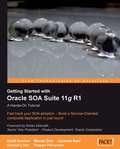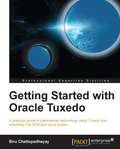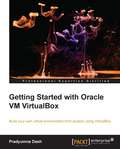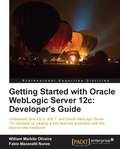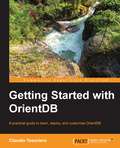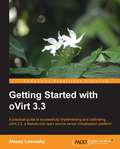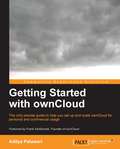- Table View
- List View
Getting Started with .NET Gadgeteer
by Simon Monk<p>Learn how to quickly build cool electronic gadgets with .NET Gadgeteer. With the easy-to-follow instructions in this guide, you’ll tackle five fascinating projects, using Microsoft’s rapid prototyping Gadgeteer platform. There’s no soldering involved—you simply plug in modules that make gadget-building quick and easy. Ideal for beginners, this book shows you how to work with modules and other hardware in the popular Fez Spider Starter Kit, and teaches you how to program your gadgets with Visual Studio C# Express and the .NET Micro Framework 4.1 SDK.</p>
Getting Started with Netduino
by Chris Walker<p>Start building electronics projects with Netduino, the popular open source hardware platform that’s captured the imagination of makers and hobbyists worldwide. This easy-to-follow book provides the step-by-step guidance you need to experiment with Netduino and the .NET Micro Framework.</p>
Getting Started with nopCommerce
by Brandon AtkinsonA friendly, tutorial style book, which will help you learn your way through creating a live storefront with nopCommerce in a step-by-step manner.Getting Started with nopCommerce is for anyone who wants to sell products online using nopCommerce. If you are a non-technical person and are discouraged by the complexity of this powerful e-commerce application, then this book is for you.
Getting Started with NoSQL
by Gaurav VaishAs with all Packt books this guide will use practical examples to impart information to the reader. Getting Started with NoSQL is a great resource for someone starting with NoSQL and an indispensable guide for technology decision makers. It is assumed that you have a background in RDBMS modeling and SQL and have had exposure to at least one of the programming languages - Java or JavaScript.
Getting Started with NSX-T: The Basic Principles of Building Software-Defined Network Architectures with VMware NSX-T
by Iwan HoogendoornThis primer on NSX-T helps you understand the capabilities and features of NSX-T, how to configure and manage NSX-T, and integrate NSX-T with other software. The book is the first in a series that will teach you the basics of NSX-T, which is an update of VMware's original software-defined networking (SDN) architecture aimed at making networks agile and flexible.You will become familiar with VMware's software-defined data center (SDDC) ecosystem and how NSX-T fits in. You will understand NSX-T components such as NSX-T Manager, NSX-T Edge Transport Nodes, and NSX-T Host Transport Nodes. And you will learn how to install and configure network services such as East/West and North/South routing capabilities, layer two switching, VRF, EVPN, multicast, and layer two bridging.The book provides best practices on how to configure routing and switching features, and teaches you how to get the required visibility of not only your NSX-T platform but also your NSX-T-enabled network infrastructure. The book explains security, advanced network features, and multi-site capabilities and demonstrates how network and security services can be offered across multiple on-premise locations with a single pane of glass for networking and security policy management. The interface with public cloud services is discussed and the book explains NSX-T operation in an on-premise private cloud and positioning and integrating NSX-T on a public cloud (off premises).What You Will Learn Understand how NSX-T fits in the VMware SDDC ecosystemKnow what NSX-T is, its components, and the terminology usedInstall NSX-TConfigure NSX-T network servicesManage the NSX-T networkWho This Book Is ForVirtualization administrators, system integrators, and network administrators
Getting Started with OAuth 2.0
by Ryan Boyd<p>Whether you develop web applications or mobile apps, the OAuth 2.0 protocol will save a lot of headaches. This concise introduction shows you how OAuth provides a single authorization technology across numerous APIs on the Web, so you can securely access users’ data—such as user profiles, photos, videos, and contact lists—to improve their experience of your application.</p>
Getting Started with OAuth 2.0: Programming Clients for Secure Web API Authorization and Authentication
by Ryan BoydWhether you develop web applications or mobile apps, the OAuth 2.0 protocol will save a lot of headaches. This concise introduction shows you how OAuth provides a single authorization technology across numerous APIs on the Web, so you can securely access users’ data—such as user profiles, photos, videos, and contact lists—to improve their experience of your application.Through code examples, step-by-step instructions, and use-case examples, you’ll learn how to apply OAuth 2.0 to your server-side web application, client-side app, or mobile app. Find out what it takes to access social graphs, store data in a user’s online filesystem, and perform many other tasks.Understand OAuth 2.0’s role in authentication and authorizationLearn how OAuth’s Authorization Code flow helps you integrate data from different business applicationsDiscover why native mobile apps use OAuth differently than mobile web appsUse OpenID Connect and eliminate the need to build your own authentication system
Getting Started with Open Source Technologies: Applying Open Source Technologies with Projects and Real Use Cases
by Sachin Rathee Amol ChobeUsing real life examples, learn how open source projects are consumed and explore the nuances within different industries in adopting open source technologies.After gaining a basic understanding of open source and open standards, understand how licensing helps turn community code into an enterprise worthy component. It also helps you understand future governance of the open source software. Once in effect, continuous security becomes a challenge for open source components so we'll examine its ongoing security aspects. This book will also cover different open source domains and industries and discuss how an enterprise can transform itself by applying key open source principles. In the end Getting Started with Open Source Technologies will provide a 360-degree view of open source and show you how to apply it. What You'll LearnUnderstand current trends in open source and why it is relevant todayGain entry into the open source world to properly license your source codeReview open source usage within different industries and apply the learnings to your enterprisesEvangelize and create advocates in open source communities Who This Book Is ForEnterprises (Developers/Operators/Management) and academics who want to get a 360-degree view of open source no matter how early or advanced they are in their adoption of any open source technology.
Getting Started with OpenBTS
by Michael IedemaDeploy your own private mobile network with OpenBTS, the open source software project that converts between the GSM and UMTS wireless radio interface and open IP protocols. With this hands-on, step-by-step guide, you'll learn how to use OpenBTS to construct simple, flexible, and inexpensive mobile networks with software.OpenBTS can distribute any internet connection as a mobile network across a large geographic region, and provide connectivity to remote devices in the Internet of Things. Ideal for telecom and software engineers new to this technology, this book helps you build a basic OpenBTS network with voice and SMS services and data capabilities. From there, you can create your own niche product or experimental feature.Select hardware, and set up a base operating system for your projectConfigure, troubleshoot, and use performance-tuning techniquesExpand to a true multinode mobile network complete with Mobility and HandoverAdd general packet radio service (GPRS) data connectivity, ideal for IoT devicesBuild applications on top of the OpenBTS NodeManager control and event APIs
Getting Started with OpenCart Module Development
by Rupak NepaliWritten as a step-by-step guide, Getting Started with OpenCart Module Development will teach you all you need to know about OpenCart, from custom extensions to module development.This book is for developers who want to develop OpenCart extensions and for those who want to learn more about the code workflow of OpenCart. Basic knowledge of OpenCart would be an added advantage.
Getting Started with OpenShift
by Steve Pousty Katie MillerIntrigued by the possibilities of developing web applications in the cloud? With this concise book, you get a quick hands-on introduction to OpenShift, the open source Platform as a Service (PaaS) offering from Red Hat. You'll learn the steps necessary to build, deploy, and host a complete real-world application on OpenShift, without having to read long, detailed explanations of the technologies involved.Though the book uses Python, application examples in other languages are available on GitHub. If you can build web applications, use a command line, and program in Java, Python, Ruby, Node.js, PHP, or Perl, you're ready to get started.Dive in and create your first example application with OpenShiftModify the example with your own code and hot-deploy the changesAdd components such as a database, task scheduling, and monitoringUse external libraries and dependencies in your applicationDelve into networking, persistent storage, and backup optionsExplore ways to adapt your team processes to use OpenShiftLearn OpenShift terms, technologies, and commandsGet a list of resources to learn more about OpenShift and PaaS
Getting Started with Oracle BPM Suite 11gR1 – A Hands-On Tutorial
by Heidi BuelowThis fully illustrated step-by-step tutorial is based on proven training content that has been highly praised by hundreds of developers in product training courses given as part of the BPM Suite 11g rollout. You will learn how to build a business process application project iteratively with each chapter introducing new technology components and adding a functional increment. Each chapter comes with a working solution for your reference. You can use the solution to start the tutorial at any point or to jump around to the chapters most interesting to you. This clear and detailed tutorial is perfect for both new and experienced business process developers, process architects, and process analysts looking for a pragmatic and hands-on approach to learning Oracle BPM Suite 11g.
Getting Started with Oracle Cloud Free Tier: Create Modern Web Applications Using Always Free Resources
by Adrian Png Luc DemancheUse this comprehensive guide to get started with the Oracle Cloud Free Tier. Reading this book and creating your own application in the Free Tier is an excellent way to build familiarity with, and expertise in, Oracle Cloud Infrastructure. Even better is that the Free Tier by itself is capable enough and provides all the ingredients needed for you to create secure and robust, multi-tiered web applications of modest size. Examples in this book introduce the broad suite of Always Free options that are available from Oracle Cloud Infrastructure. You will learn how to provision autonomous databases and autonomous Linux compute nodes. And you will see how to use Terraform to manage infrastructure as code. You also will learn about the virtual cloud network and application deployment, including how to create and deploy public-facing Oracle Application Express solutions and three-tier web applications on a foundation of Oracle REST Data Services. The book also includes a brief introduction to using and managing access to Oracle Machine Learning Notebooks.Cloud computing is a strong industry trend. Mastering the content in this book leaves you well-positioned to make the transition into providing and supporting cloud-based applications and databases. You will have the knowledge and skills that you need to deploy modest applications along with a growing understanding of Oracle’s Cloud platform that will serve you well as you go beyond the limits of the Always Free options and take full advantage of all that Oracle Cloud Infrastructure can offer.What You Will LearnKnow which resources are available for free forever from Oracle Cloud InfrastructureProvision your virtual cloud networkHost, manage, and monitor web applications using the freely available componentsProvision and manage Autonomous Databases and Autonomous Linux Compute NodesUse and manage access to Oracle Machine Learning NotebooksAutomate and manage your infrastructure as code using TerraformMonitor and manage costs when you grow beyond the Always Free platformWho This Book Is ForDatabase administrators and application developers who want to learn about Oracle’s cloud offerings, application developers seeking a robust platform on which to build and deploy modest applications at zero cost, and developers and administrators interested in exploring Oracle Application Express running on a self-managing, self-tuning Oracle Database
Getting Started with Oracle Data Integrator 11g: A Hands-On Tutorial
by David Hecksel Peter C. Boyd-Bowman Bernard WheelerGetting Started with Oracle Data Integrator 11g: A Hands-On Tutorial is a practical tutorial bursting with tips, illustrations and real-world best practices to get you on your way with ODI. If you are a software/ETL developer or database administrator who is new to Oracle Data Integrator but want to get hands-on with the product quickly, then Getting Started with Oracle Data Integrator 11g: A Hands-On Tutorial is for you. You should have some experience with databases, SQL and ETL technologies.
Getting Started with Oracle Event Processing 11g
by Alexandre Alves Robin J. Smith Lloyd WilliamsThis getting started book will use practical chapters which follow logical and progressively more complex tasks and examples, which will impart the skills of how to use Oracle Complex Event Processing to the reader. This book is aimed at both those with some knowledge of java and SQL database experience, but it is also written so that if you are completely new to this topic you will understand this new technology domain no matter your background or industry.
Getting Started with Oracle Hyperion Planning 11
by Enti Sandeep ReddyThis book follows a tutorial-based approach that will provide you with step-by-step instructions to configure and implement a robust planning, budgeting, and forecasting solution. Each chapter provides clear instructions and detailed screenshots, as you approach a new facet of the Hyperion Planning environment. If you want to successfully implement Oracle Hyperion Planning solutions, then this book is for you. Familiarity with Oracle Essbase and OLAP would be beneficial but is not essential. While the book is intended for beginners, even experienced Planning developers and users will benefit from this book.
Getting Started with Oracle Public Cloud
by Hemant Kumar MehtaA step-by step tutorial to get started with Oracle Public Cloud and its services. This book is targeted at users who wish to explore the Oracle Public Cloud services. Readers should be well aware of Java Enterprise Edition, Oracle Database, and JMS.
Getting Started with Oracle SOA B2B Integration: A Hands-On Tutorial
by Alan Perlovsky Krishnaprem Bhatia Scott HaalandThis hands on tutorial gives you the best possible start you could hope for with Oracle B2B. Learn using real life scenarios and examples to give you a solid footing of B2B.This book is for B2B architects, consultants and developers who would like to design and develop B2B integrations using Oracle B2B. This book assumes no prior knowledge of Oracle B2B and explains all concepts from scratch using illustrations, real world examples and step-by-step instructions. The book covers enough depth and details to be useful for both beginner and advanced B2B users.
Getting Started With Oracle SOA Suite 11g R1 – A Hands-On Tutorial
by Heidi Buelow Demed L'HerThis fully illustrated step-by-step tutorial is based on proven training material that has been highly praised by hundreds of developers in product training courses given as part of the SOA Suite 11g rollout. You will learn how to build a services-oriented composite application project iteratively with each chapter introducing new technology components and adding a functional increment. Each chapter comes with a working solution for your reference. You can use the solution to start the tutorial at any point or to jump around to the chapters that most interest you. This clear and detailed tutorial is perfect for both new and experienced SOA developers looking for a pragmatic and hands-on approach to learning Oracle SOA Suite 11g.
Getting Started with Oracle Tuxedo
by Biru ChattopadhayayThis book is packed with real world examples that cover the design and discipline of the software and service of CRMOD. If you are an architect, designer, developer or administrator looking for a quick reference guide on how to build a Tuxedo application, then this is the best guide for you. This book also helps business users to understand this technology, various features, and functionalities and relate business benefits. No prior knowledge of Tuxedo is required.
Getting Started with Oracle VM VirtualBox
by Pradyumna DashThis book is for system administrators, technical architects, and virtualization enthusiasts who want to learn how to set up a virtual machine. Knowledge of the Linux environment is expected. Prior experience with VirtualBox or knowledge of virtualization is not required.
Getting Started with Oracle WebLogic Server 12c: Developer’s Guide
by William Markito Oliveira Fabio Mazanatti NunesGetting Started with Oracle WebLogic Server 12c is a fast-paced and feature-packed book, designed to get you working with Java EE 6, JDK 7 and Oracle WebLogic Server 12c straight away, so start developing your own applications.Getting Started with Oracle WebLogic Server 12c: Developer's Guide is written for developers who are just getting started, or who have some experience, with Java EE who want to learn how to develop for and use Oracle WebLogic Server. Getting Started with Oracle WebLogic Server 12c: Developer's Guide also provides a great overview of the updated features of the 12c release, and how it integrates Java EE 6 and JDK 7 to remove boilerplate code.
Getting Started with OrientDB
by Claudio TesorieroA standard tutorial aimed at making you an OrientDB expert, through the use of practical examples, explained in a step-by-step format.Getting Started with OrientDB 1.3.0 is great for database designers, developers, and systems engineers. It is assumed that you are familiar with NoSQL concepts, Java, and networking principles.
Getting Started with oVirt 3.3
by Alexey LesovskyGetting Started with oVirt 3.3 has a tutorial-based approach to learning oVirt KVM virtualization. This book will introduce you to the various components of the oVirt engine and will show you how to implement virtualization.This book is designed for technicians and system administrators who are interested in virtualization technology in Linux / UNIX. It is assumed that you have an understanding of virtualization in general as well as what issues it solves. You will also need a basic knowledge of how to work on the command line in Linux.
Getting Started with ownCloud
by Aditya PatawariThis is a standard, precise, and short tutorial for setting up ownCloud and includes advanced topics like encryption, user management, and server security. This ownCloud book would be an ideal starting point for anyone who wants to store their data and also share it.This book is for first time users as well as administrators who are interested or responsible for managing an ownCloud instance. You do not need any prior experience with any of the technology, including Linux/Windows, Apache/IIS, SQLite/MySQL, or even PHP. It is a beginner-friendly book, written with a first time user in mind.
